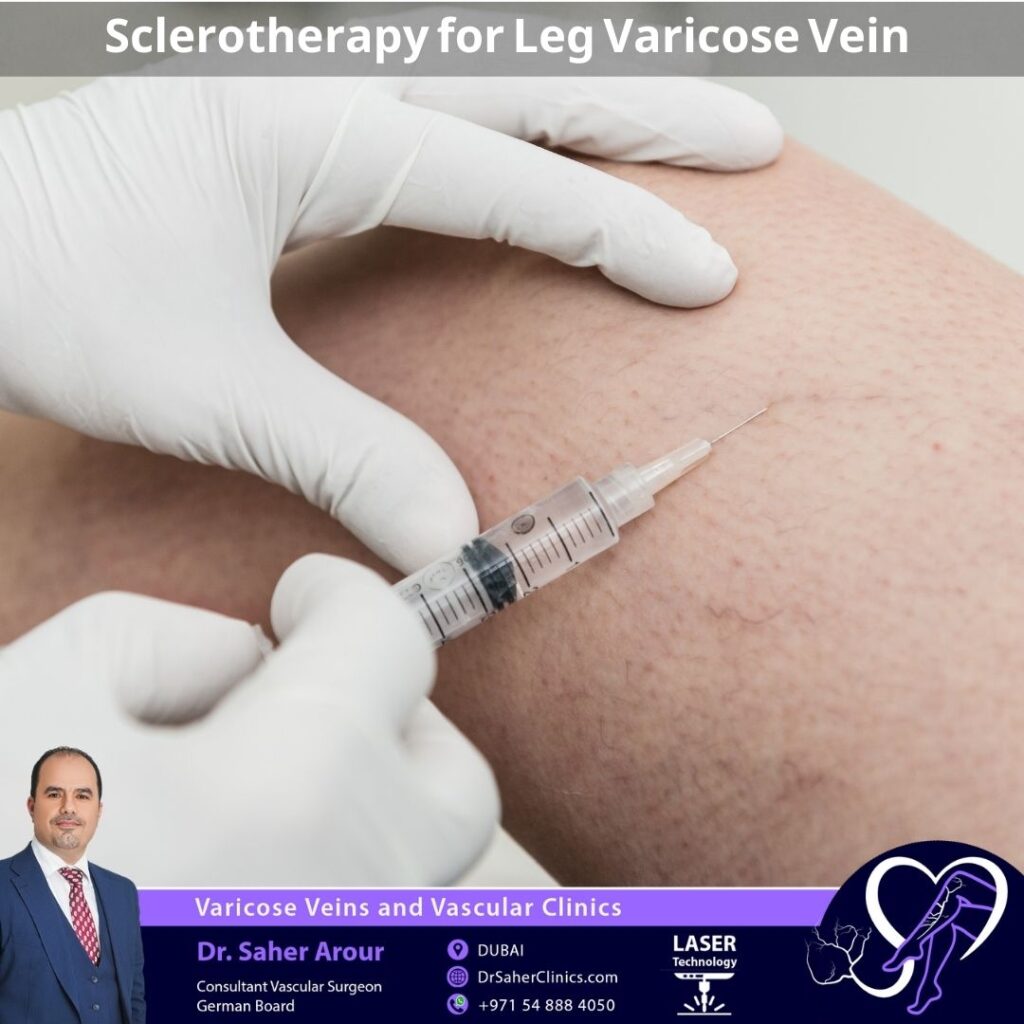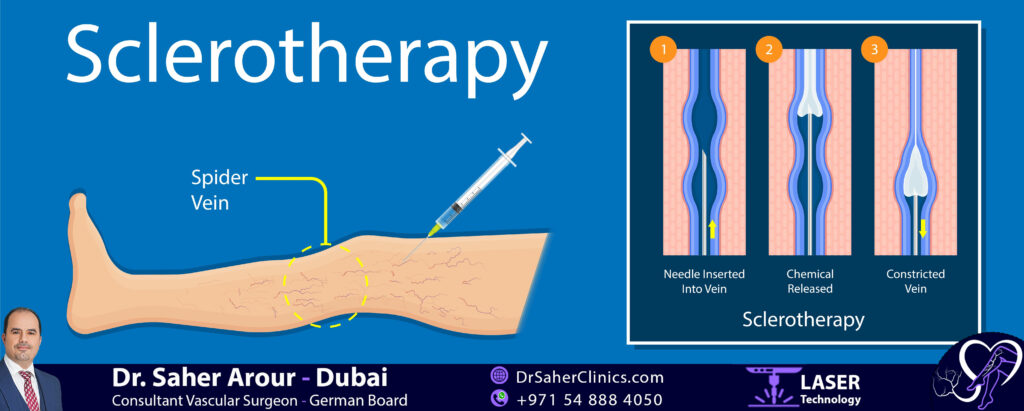Sclerotherapy: A Modern Technique for Varicose Vein Treatment

Sclerotherapy is a modern technique for treating varicose veins and is considered the most effective approach in 2023. It is the primary choice when appropriate for varicose veins requiring treatment. One of its notable advantages is that it is virtually painless. Patients may experience mild discomfort, itching, or tingling at the treatment site. It is available at six of the leading varicose vein clinics in Dubai, under the supervision of Dr. Saher.
Areas Treatable with Sclerotherapy:
- Varicose Vein Lower Limbs
- Facial Varicose Veins
- Varicocele
- Pelvic Congestion Syndrome
- Esophageal Varices
- Uterine Varicose Veins
- Vulvar Varicose Veins
- Upper Limb Varicose Veins
Varicose Veins Suitable for Sclerotherapy:
Sclerotherapy can be used to treat twisted, spider-shaped, and small-diameter varicose veins. The specifications of varicose veins that can be treated with sclerotherapy include:
- Highly twisted varicose veins
- Spider veins
- Varicose veins with small-diameter veins
Details of Sclerotherapy Treatment:
During varicose vein sclerotherapy treatment, a specialized physician injects a medical solution into the affected vein using a very thin needle. This solution completely seals the affected vein, redirecting the blood flow to healthy veins. The closed, affected vein gradually fades away.
Benefits and Results of Sclerotherapy Varicose Vein Treatment:
- Improvement in Cosmetic Appearance: Sclerotherapy is an effective way to eliminate varicose vein-related deformities, enhancing the appearance of the legs and boosting self-confidence.
- Symptom Relief: Varicose veins can cause pain, swelling, and itching in the legs. Sclerotherapy can alleviate these symptoms, improving the patient’s comfort.
- Reduced Risk of Complications: Varicose veins can potentially lead to health complications such as deep vein thrombosis and leg ulcers. Sclerotherapy reduces these risks, preserving the patient’s overall health.
Sclerotherapy Procedure Location:
Sclerotherapy is typically performed externally at the physician’s clinic and usually does not require general anesthesia. A substance that induces blood clotting is injected into the affected vein using a thin needle. Patients may feel some pressure or burning during the injection, but the procedure is generally painless.
Complications and Risks:
Although sclerotherapy is safe and effective in most cases, there are some rare complications that can occur. These complications may include the possibility of deep vein thrombosis, blood clot formation, or skin inflammation. Sclerotherapy involves inserting a thin needle into the skin, which may cause the following side effects, which typically disappear within weeks or a few months:
- Bruising
- Redness of the skin at the treatment site
- Appearance of tiny red blood vessels
There are also rare side effects of sclerotherapy that may require treatment, including:
- Inflammation: Inflammation may occur around the needle entry site, possibly accompanied by swelling or elevated skin temperature. In such cases, the doctor may recommend taking specific medications like aspirin, ibuprofen, or other suitable options.
- Blood Clot: If a blood clot forms in the treated vein, it may need to be drained. In rare cases, the blood clot may move to a deeper vein in the leg, known as deep vein thrombosis (DVT), which carries a risk of the clot traveling to the lungs, causing a life-threatening condition known as pulmonary embolism. This is a rare complication of sclerotherapy and requires urgent medical care. Symptoms may include difficulty breathing, chest pain, dizziness, and coughing up blood.
- Air Bubbles: Small air bubbles may appear in the blood, typically causing no noticeable symptoms. However, other possible symptoms include seeing flashes of light, experiencing a headache, fainting, and nausea. These symptoms usually resolve naturally without the need for medical intervention. However, if there are issues with mobility or sensation in the arms or legs after the procedure, it’s essential to contact the doctor for evaluation and guidance.

Preparation at Home:
- Avoid hair removal or using creams on the areas where varicose veins will be treated.
- Wear loose and comfortable clothing.
How to Prepare for Sclerotherapy:
Before undergoing sclerotherapy, the specialist physician will assess the condition of your varicose veins and may request some general physical examinations to ensure vascular health. They will discuss your medical history and that of your family, which includes asking questions such as:
- Any recent illnesses or health conditions, such as heart problems or a history of blood clots.
- Any allergies you may have.
- Previous varicose vein treatments and their outcomes.
- Medications or dietary supplements you are taking, including aspirin, ibuprofen, iron supplements, herbal supplements, and blood thinners. It’s essential to note that some medications and supplements may affect your blood clotting ability, so consult your healthcare team regarding when to stop taking them before the procedure.
Duration of Sclerotherapy:
Sclerotherapy typically takes one hour or less.
Location of Sclerotherapy Procedure:
Sclerotherapy is usually performed in the doctor’s varicose vein clinic, equipped with the latest suitable devices to complete the procedure.
During the Sclerotherapy Procedure:
You will lie on your back with both legs slightly elevated. A member of the healthcare team will clean the treated area. Then, the doctor will use a very fine needle to inject the solution into the vein slowly. The solution irritates the vein lining, causing it to swell and close. This redirects blood flow to other healthy veins, and the closed vein gradually disappears. Some patients may feel a slight pinch or cramping when the needle is inserted into the vein. If you experience severe pain due to this, you should inform the doctor. Pain may result from the solution leaking from the vein into the surrounding tissues. After removing the needle, the doctor will apply pressure and massage the area to prevent blood from entering the vein and spreading the solution. A bandage may be placed over the injection site for compression before moving on to the next vein.
Number of Injections:
The number of injections depends on the number of veins that need treatment, but a single vein may be injected more than once.
After Sclerotherapy Procedure
Compression Stockings for Leg Veins
You can stand up and walk shortly after the procedure to prevent blood clots. It is advisable to use compression stockings or bandages for approximately two weeks to provide continuous pressure on the treated veins. Avoid shaving or using creams on the legs until the surgical site is fully healed.
Activities on the Following Day
Most people return to their daily activities on the same day, but it is recommended to have someone accompany you home after the procedure. You may be advised to avoid strenuous exercise for two weeks after the procedure.
Sun Exposure for Facial Veins
It is also important to avoid direct sunlight exposure to the treated areas for about two weeks. You can use sunscreen with a minimum SPF of 30, as sun exposure can lead to the development of dark spots on the skin, especially for individuals with darker skin tones.
Follow-up After the Procedure
Dr. Saher will schedule a follow-up appointment for you approximately one month after the procedure to assess the results, and you may need additional sessions. In general, you should wait up to six weeks before undergoing another session of sclerotherapy treatment.
Results of Varicose Vein Treatment with Sclerotherapy
The results of sclerotherapy treatment for small veins and spider veins typically become visible within 3 to 6 weeks, and for larger veins, it may take 3 to 4 months. In some cases where there are varicose veins of varying sizes and shapes, multiple treatment techniques may be required to achieve the desired results. Generally, the treated veins disappear completely, but new veins may appear.
Other Varicose Vein Treatment Techniques
- Laser Endovenous Ablation (EVLA)
- Radiofrequency Ablation
- Endovascular Therapy (Vein Closure)
- Q&A About Sclerotherapy
Sclerotherapy Varicose Vein Treatment Q & A
Q1: Is sclerotherapy safe for pregnant women?
A1: Experts recommend postponing sclerotherapy until after childbirth and the end of the breastfeeding period.
Q2: What is sclerotherapy for varicose veins?
A2: Sclerotherapy for varicose veins is a procedure that involves injecting a specific solution into the veins to cause narrowing of the affected veins. This leads to the blockage of the veins and the disappearance of varicose veins over time.
Q3: What are the benefits of sclerotherapy for varicose veins?
A3: Sclerotherapy for varicose veins offers several benefits, including improving the appearance of varicose veins, reducing associated pain and swelling, and enhancing blood flow while addressing circulatory problems associated with varicose veins.
Q4: Is sclerotherapy for varicose veins safe and effective?
A4: Yes, sclerotherapy for varicose veins is considered a safe and effective procedure for many patients. The procedure involves injecting a solution that causes the veins to close off, making it a safe method for treating varicose veins without the need for traditional surgery.
Q5: How long does recovery take after sclerotherapy for varicose veins?
A5: The recovery time after sclerotherapy for varicose veins varies from patient to patient. Typically, patients can return to their daily activities shortly after the procedure, and the results achieved from the treatment can last for a long time.
